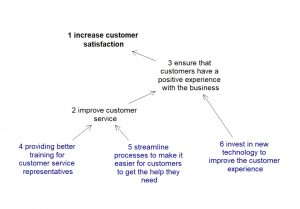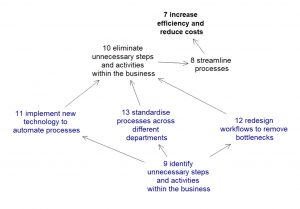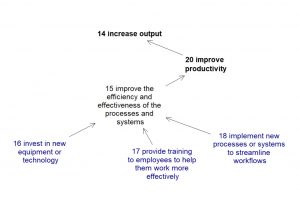What is an Operational Goal?

Operational goals support the overall strategy by providing the necessary resources and support to achieve the long-term strategic goals and vision of the business. Strategic goals tend to be broad and longer-term in nature. Operational goals, on the other hand, tend to be short-terms and focused on specific outcomes.
Setting smaller more achievable goals and objectives helps ensure that progress is being made towards achieving the overall strategic goals. Importantly, this also creates ‘quick wins’ for the business. When people see progress they become motivated to continue to work towards the long-term goals.
Linking operational goals to strategic goals
It is important that operational goals are linked to and support the overall strategic goals of the business. This helps ensure that the business is working towards its long-term objectives and mission.
To link operational goals to strategic goals, a business must first create its strategic goals. Having agreed on the strategic goals we drill down into more specific and focused operational goals. Repeatedly ask “how do we achieve that?” is a common technique used to uncover the objectives and goals that support the strategic goals.
For example, if a strategic goal of an organisation is to expand into new markets, operational goals might include things like improving the organisation’s marketing efforts, developing new products or services to meet the needs of the new market, or ensuring employees are able to effectively sell to customers in new markets. These operational goals would help the organisation achieve its strategic goal of expanding into new markets by providing the necessary resources and support to do so.
By linking operational goals to strategic goals in this way, an organisation can ensure that its daily activities are focused on achieving its long-term goals and advancing towards its overall vision.
The power of causal mapping
Causal mapping is a very powerful tool that helps organisations link their operational goals to their strategic goals. It does this by creating a visual representation of the cause-and-effect relationships between the operational and strategic goals.
By creating a causal map, businesses can identify the key drivers that are most important for achieving their strategic goals, as well as the operational goals that are most critical for achieving those drivers. This helps them focus their resources on the most important activities and allocate their resources more effectively.
In addition, causal mapping can also be used to identify potential bottlenecks or challenges that may be hindering progress towards achieving those goals. By identifying these challenges early on, businesses can take proactive measures to address them and improve their chances of success.
Measuring Progress
Operational goals and objectives should meet the SMART criteria. This is because tracking progress towards achieving them is also important because it helps ensure that the organisation is making progress to achieving its overall strategic goals and vision.
Working in this way ensures that operational objectives are effective in driving progress and improving performance. It also helps the business stay focused on the tasks and activities that are necessary to achieve its overall strategic goals and vision.
Examples
Here are some examples of how operational goals can help an organisation achieve its strategic goals:
Customer Satisfaction: If a strategic goal of an organisation is to increase customer satisfaction, operational goals related to improving customer service can help support this goal by ensuring that customers have a positive experience with the business.
This might include things like providing better training for customer service representatives, streamlining processes to make it easier for customers to get the help they need, and investing in new technology to improve the customer experience.
Improve efficiency: If a strategic goal is to increase efficiency and reduce costs, operational goals related to streamlining processes can help support this goal by identifying and eliminating unnecessary steps and activities within the organisation.
This might include things like implementing new technology to automate processes, redesigning workflows to remove bottlenecks, and standardising processes across different departments.
Increasing productivity: If a strategic goal is to increase output or productivity, operational goals related to improving the efficiency and effectiveness of the organisation’s processes and systems can help support this goal.
This might include things like investing in new equipment or technology, providing training to employees to help them work more effectively, or implementing new processes or systems to streamline workflows.



